There have been a mere handful of guitar designs over the decades that redefined not just how a guitar looks, but how it is built. A number of those innovations have come from Gibson, and one that also helped change the face of popular music has been the Gibson ES-335 along with its siblings. The 335 has found a home across every genre of music since its introduction in 1958. In this article, we're going to take a look at the history of this archetypal guitar, along with a number of the players who helped make it the icon it is today.
Table of Contents
What Makes the ES-335 So Iconic?
The Early History of the Gibson ES-335
Precursors to the ES-335
The Development of the ES-335
1958: The Introduction of the Gibson ES-335
1959—1963: The Years the ES-335 Took Off
1964—1968: Changes to the ES Family
1968—1986: Changes to the ES-300 Family During the Norlin Years
The ES-300 Family from 1986 to Present—Gibson Reborn
A Timeline of Changes Made to the Gibson ES-335 and 300 Series
Meet the Modern ES-300 Family
Comparing Gibson's ES-300 Models
15 Essential ES-335 Family Players and Songs
Honorable Mentions
Putting it in the Case
What Makes the ES-335 So Iconic?
Over the years, a lot of players have put forth the argument that the ES-335-style guitar is the most versatile electric guitar you can buy. Looking at the range of players and musical styles this archetype of the double-cutaway, semi-hollow instrument has been associated with, it's hard to disagree with that opinion. But what is it, exactly, that makes that claim hold water?
As with all electric guitars, you have to start with tone. The basic tone of the ES-335 is more organic than a full solidbody guitar, but without the "woof" that can come from a fully hollow instrument. Its slightly mid-focused nature cuts through, without being excessively nasal, and the range of tones that can be gotten by those who aren't afraid to touch the volume and tone knobs is vast, ranging from country chicken pickin' on the bridge humbucker, to warm, round jazz tones from the neck pickup. Thanks to the 335's semi-acoustic nature, it can be rich and full, and the solid center block makes it resistant, but not too resistant, to feedback at higher volume levels.
It's also an exceptionally comfortable guitar to play. The combination of a relatively thin (in both depth and width) neck, smoothly tapered neck carve and easy upper fret access has made it an excellent instrument for both rhythm playing and single-note soloing. The body, though it may seem large at first glance, fits comfortably for most players (and if it is a little larger than you like, there's the ES-339, a smaller-bodied version, about which more later).
And, finally, they just look cool—like you're really serious about playing, and being seen as that, the attitude carries over to what you play and how you play it.
The Early History of the Gibson ES-335
From its conception in 1957 to the first production models emerging from Gibson's Kalamazoo, MI factory in 1958, it took less than a year for the ES-335 to come to fruition. Although there had been some products that may have seeded the idea in the minds of Gibson engineers and executives, bringing these disparate elements together happened at surprising speed. Gibson had been having success with their thinner versions, the full-depth jazz guitars in their ES (for Electric Spanish) guitars like the Byrdland, the ES-225T and the ES-350T, which was being played by some guy from St. Louis named Chuck Berry. But they were under pressure to create something new, as the radical body shapes and hipper vibe from those California upstarts at Fender were feeding the idea that Gibson was stuck in the past and just coasting on previous successes. But, as revolutionary as the ES-335 was to be, it didn't necessarily spring full-blown from the minds at Gibson.
Precursors to the ES-335
So, what guitars might have been the germination of the ES-335 concept? First, and maybe foremost, considering his long association with Gibson, was Les Paul's "Log" guitar—a 4"x4" piece of wood with wings sawed off of an Epiphone arch top glued onto the sides that Paul created in the late 1930s as a proof of concept for a solidbody electric guitar. In the late 1940s, he first approached Gibson with the idea of putting a solidbody into production, and had shown them that instrument at the time.
A second predecessor was likely a mid-1950s model from Kay, the K161 "Thin Twin" that used a pair of parallel rails in a thin-body electric to both strengthen the body and provide mounting points for pickups.
Lastly, it might have been several guitars from Gretsch (the Jet Series) and Rickenbacker that used a carved-out solid block of wood for the back and sides, leaving a solid center for mounting pickups. These did not have much of an acoustic presence, as the carving was, according to sources, mostly for weight reduction.
We'll probably never know for sure. What we do know is that in early 1957, Gibson President Ted McCarty went to his head woodworking engineer, Larry Allers, and asked him to design some options for a thin-body guitar for the ES series that used a solid center block—a sort of semi-solid, or semi-hollow (is the glass half-empty or half-full?), electric guitar.
The Development of the ES-335
There were some unique challenges to creating this new style of guitar. A flat, solid, end-to-end center block would be fairly easy to produce, but the guitar was intended to have an arched top to match the already existing ES family members. The solution that Larry Allers, consulting with Ted McCarty, came up with, was elegant—use strips of spruce, notched so they could flex (this is known as a kerf cut) glued to the front and back of the center block. These strips would shape themselves to match the arch of the pressed laminate top, while still providing support and behaving as if it were a completely solid block.
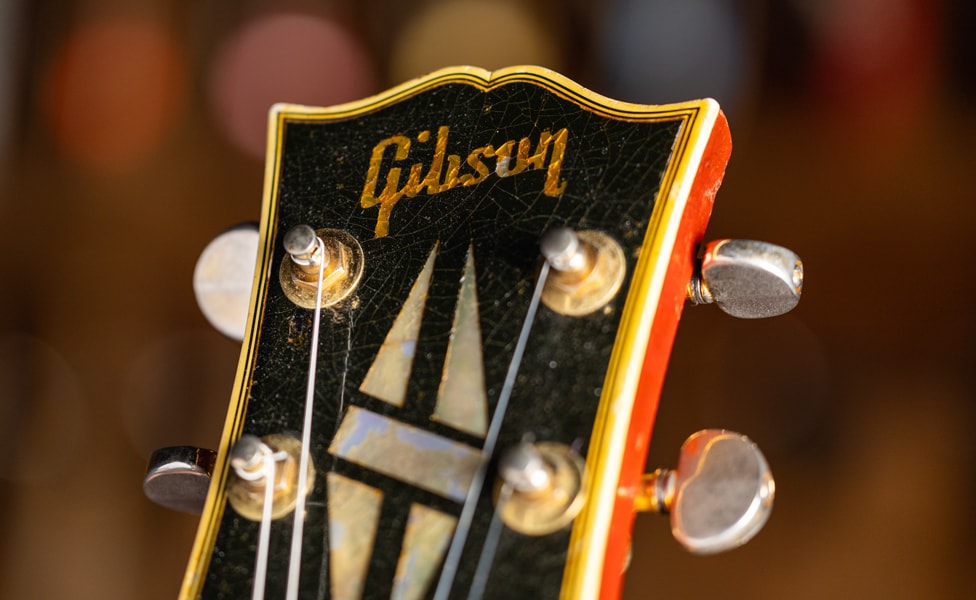
Pictured: 1959 Gibson ES-335 Headstock
The top, back and sides were originally designed as a three-layer laminate of maple/poplar/maple, with the inner and outer layers of maple having the grain running the same direction, and the grain of the inner poplar layer at 90° to that to add strength. This wood sandwich would then be placed in heated hydraulic presses to create the final compound arches of the top and back of the guitar. The neck would be one-piece mahogany with an unbound, dot-inlaid rosewood fingerboard.
The addition of Gibson's newly designed humbuckers and a stop tailpiece—though that would change later, as seen in the section on The Evolution of the ES-300 Family—rather than the traditional "trapeze" tailpiece, gave the new design a distinctive look that set it apart from its fully hollow relatives in the Electric Spanish line. As with the Les Paul Deluxe and Custom, a Bigsby vibrato tailpiece would be an available option. Once the final prototype had been approved by Gibson management, the ES-335 was ready to greet the world.
1958: The Introduction of the Gibson ES-335
By February 1958, Gibson had built the last prototype and made some samples of the ES-335 to ship to Chicago Musical Instruments (CMI), who was Gibson's parent company and distributor. The first recorded production serial numbers for the ES-335 are recorded in April 1958, just in time for the Summer NAMM show in Chicago, where Gibson would debut several new guitars, the double-cut Les Paul Jr. and Special, the radical design of the Flying V, plus the equally radical—though not in quite as visible a way—ES-335.
Gibson management may have still not entirely been sure how well dealers would accept the double-cutaway shape in what was, at first glance, a normal thinline archtop guitar. Their biggest push, at least judging by existing photos of the Gibson exhibit, was for the new solidbody guitars, with the ES-335 relegated to the far end of the line, tucked in a corner. But apparently dealer response was much better than originally expected, and the next Gibson catalog would have the ES-335 featured prominently, and plans were put in place to expand the new thinline, semi-hollow family.
The first of the changes that would happen over the decades to the ES-335 occurred later in 1958. Up until this point, dot markers on the fingerboard had been a sign of the lower end of Gibson's product line. But the 335 didn't exactly fall into that category, so the decision was made to add binding to the neck for a slightly more upscale image. Also, the cutaways were changed from being slightly pointed to a more rounded shape that came to be known as "Mickey Mouse ears," and the bulge in the cutaways that gave the appearance of a carved top were slightly raised. At around that same time, the top, back and sides were changed to a four-layer laminate for some added strength, as the three-layer tops had shown a tendency to develop cracks around the input jack. Apparently, some of the "thin-top" units were still shipping in early 1959, as Gibson, like most guitar manufacturers, was always loath to toss parts that had already been produced.
At this same time in late 1958, Gibson released the premium member of the family, the ES-355, which was loaded with high-end appointments like pearl block inlays starting at the first fret of the ebony fingerboard, triple binding on the body and Gibson's split diamond headstock inlay—reserved for the upper end of Gibson's instruments since it debuted on the Super 400 archtop in 1934. Also released at the end of the year was the fully hollow thinline ES-330, which, with P90 pickups, an unbound fingerboard and a trapeze tailpiece, was to be the entry-level instrument in the ES-300 family. The remaining member of the family, the mid-level ES-345, would have to wait until the spring of the following year.
An interesting side note here concerns the optional Bigsby vibrato tailpiece. Since all the guitars were being built with the stud holes for the stop tailpiece pre-drilled, instruments on which the Bigsby had been ordered would have had a pair of holes in the top of the guitar. Gibson's solution to this, on the earliest builds, was to use large pearl inlay dots to cover the holes. On slightly later guitars, they changed to a plastic plate engraved with "Custom Built" that covered the two holes.
1959—1963: The Years the ES-335 Took Off
The ES-300 family, and the ES-335 in particular, would make a big splash over the next couple of years. The essential changes that had occurred at the end of 1958 had solidified the guitar, and its combination of a more traditional look with some extraordinary new construction methods led to a guitar that was to become a standard across many musical genres in the coming years.
Although Gibson had thought jazz guitarists would be quick adopters of the new guitar, it was making more of a dent in other genres. It was during this period that both Chuck Berry and B.B. King (see our section on ES-335 players) picked up their first ES-335, and country guitar legend Hank Garland, one of the codesigners of the Gibson Byrdland thinline hollowbody, had switched over to semi-hollowbody instrument.
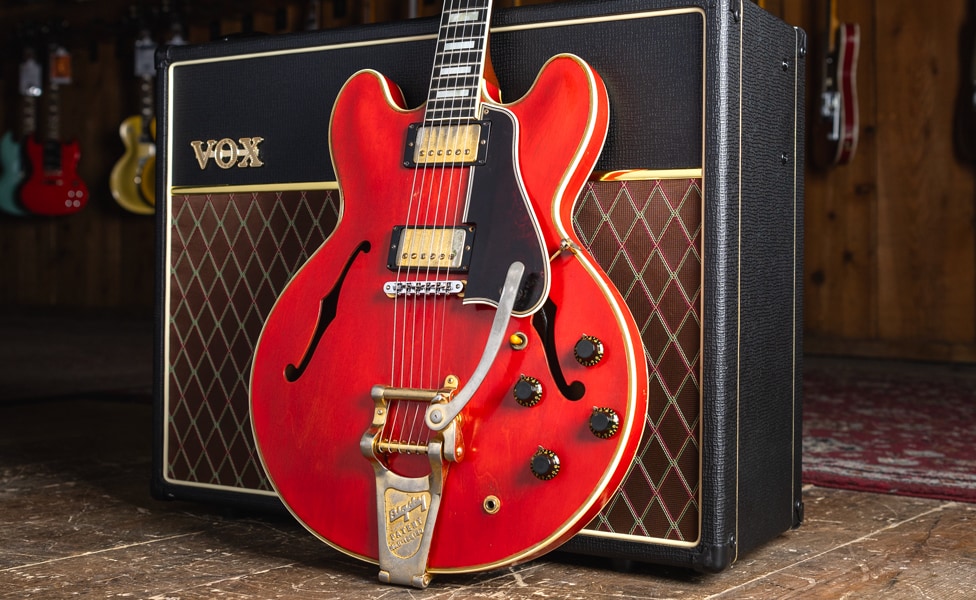
Pictured: 1959 Gibson ES-335 in Cherry Red
The only major change to the ES-335 in 1959 was the addition of a cherry red finish—clear lacquer over a bright red stain—to the original ES-335 finishes of sunburst and natural. Interestingly, cherry red had first appeared on a signature L5 guitar made for comedian and television personality George Gobel in 1958, and customer reaction to the finish soon led Gibson to make it available on quite a few Gibson models.
It's probably worth noting here that at the same time Gibson was developing and refining the ES-300 family, they were also designing related models for Epiphone, a long-time competitor they had bought in 1957 and moved their production to the Kalamazoo factory. The Epiphone Sheraton and Casino, for example, were versions of the ES-335 and ES-330, respectively. You can even make the case that the Casino ended up as a more popular guitar than the ES-330 it emulated.
1959 also saw the introduction early in the year of the ES-345 with its stereo wiring and unique Varitone rotary tone switch. The Varitone has been a hot topic of conversation over the decades, with some players loving the unique sound of its tuned notch filters and others bypassing it, or removing it altogether.
When Gibson started producing ES-335 guitars in 1958, they used the same pickguard as the rest of the ES series in order to avoid tooling to make a new pickguard for an as yet unproven instrument. The result was a pickguard that extended below the bridge. Guitars with this pickguard, known as "Long Pickguard" ES-335s, are quite in demand on the vintage market. But in 1960, Gibson had become convinced that the ES-335 and siblings would be around long enough to merit a properly proportioned pickguard of its very own. There were also changes to the original gold knobs, with the addition of a metal cap, and the Kluson tuner knobs were changed from single ring to double ring. 1960 also witnessed the phasing out of the natural finish, making sunburst and cherry the available options, aside from custom orders.
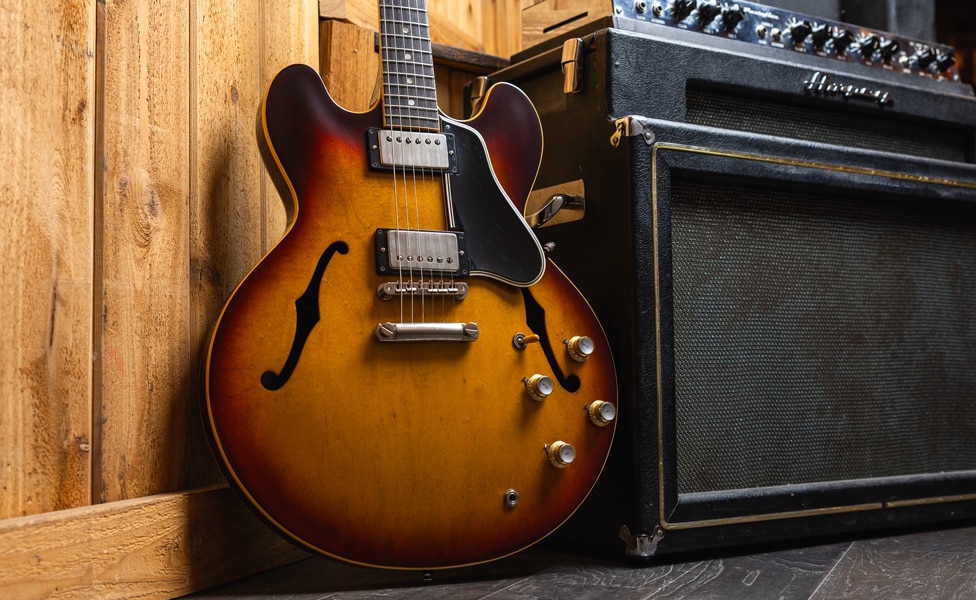
Pictured: 1961 Gibson ES-335 in Sunburst
1961 saw the release of the "sideways" Vibrola tailpiece as an option on the ES-335, though it was standard on the top-line ES-355. As this design had some issues with reliably returning to pitch, many guitar players took advantage of the folding feature of the arm and simply moved it out of the way.
1962 was to feature one of the major cosmetic changes in the ES-335 timeline, with dot inlays being replaced with pearl blocks, as suited a guitar that had established itself as more than an entry-level instrument. This change was also made to the ES-330, possibly in an attempt to give it a more upscale image, though the fingerboard would remain unbound.
For its fifth anniversary in 1963, the ES-300 line saw the sideways Vibrola replaced with a more traditional "up-and-down" Vibrola with a fancy etched lyre and leaves design along with the Gibson logo on its cover. The "Mickey Mouse ear" cutaways were also made somewhat less rounded, putting the ES-335 into the basic form it would hold for a number of years to come.
1964—1968: Changes to the ES Family
The next four years would see only a few changes in the ES-335—two important and one perhaps considered a precursor of things to come.
In 1965, the trapeze tailpiece became the standard on the ES-335 and ES-345, replacing the stop tailpiece and making a fairly major change in how the guitar felt to play.
The original neck design of the one-piece mahogany neck had called for the 17° headstock rake that had been standard across the whole ES line. While this made for a better break angle over the nut and increased stability in tuning, it also made the area of transition more prone to fracture, especially on heavier guitars like the solidbody Les Pauls and the semi-hollow ES-335, due to the shorter grain in that angled section. After having to repair one too many cracked headstocks, in 1965, Gibson changed the headstock rake angle to 14° across the whole ES-300 family, making the headstock sturdier at a minimal cost to tuning stability. There is a whole school of argument about just how much that change was, but we're staying out of that other than to say that personal experience playing pre-1965 and post-1965 ES-335s showed it to be a negligible difference on that front. Your mileage, as they say, may vary.
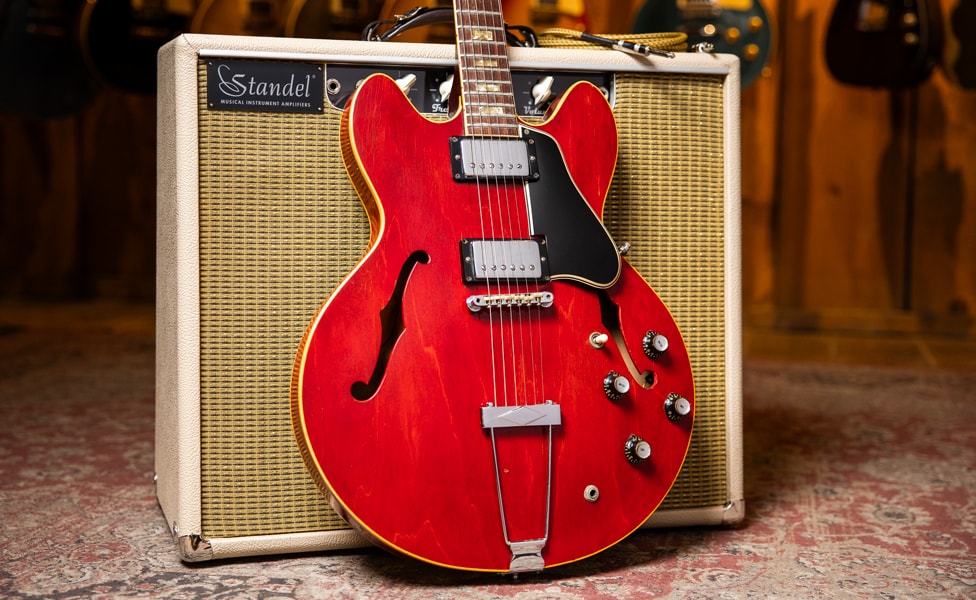
Pictured: 1966 Gibson ES-335 in Cherry Red
The other change overlapped with the acquisition of CMI (remember them?)—who owned Gibson—by ECL, which was a larger conglomerate. The combined companies changed their name to Norlin, a portmanteau of the beginning of the name of ECL chairman Norton Stevens and the last syllable of CMI founder Maurice Berlin. The change, which seemed strictly a cost-cutting move, was to replace the inlaid Gibson logo on the headstock with a painted one. These were put on by pantograph, a fascinating mechanical contraption for duplicating artwork, at a substantial time, labor and material savings. This trend toward cost cutting over craftsmanship would be, for better or worse, a major part of the story of the ES-335 under Norlin's ownership.
1968—1986: Changes to the ES-300 Family During the Norlin Years
While feelings tend to be that Norlin drove down overall quality across the entire Gibson line—some have still not forgiven the shuttering of the original Kalamazoo factory in 1975—over the next 18 years, there was a surprising amount of experimentation happening with guitars and construction under their ownership. In lieu of doing a year-by-year breakdown of changes here, we're going for more of a 30,000' view of how it affected the ES-335.
Certainly, much of what Norlin did across the board can be attributed to cost cutting to increase profitability. Switching from holly (a soft, easy-to-mill wood) to fiberboard for headstock overlays and adding the much-hated volute (a reinforcing "bump" to the back of the headstock in an attempt to further reduce the incidence of fractured headstock joints) were among those. The center block was also reengineered to remove the two small, separate mahogany end blocks, simplifying the manufacturing process and reducing parts count.
Norlin also switched to three-piece laminated necks, which enables the use of wood that would not be suitable for a one-piece neck. The laminated construction is arguably stronger but is sometimes perceived as sounding less organic than a single-piece would be.
During this same time period, Norlin also experimented with adding coil taps and additional switching options to the ES-335. There was also the addition of new features that may have been interesting (tuners with built-in pop-out cranks, the TP-6 Fine Tuning tailpiece) but did not stand the test of time. A certain amount of change seems to have come from chasing trends—pickup covers being removed on some models, or new cosmetics, like on the ebony finish ES-335 Custom, with aesthetics that mirrored the Les Paul Custom, or the ES-335 Country Rock version, which came in regular and stereo versions, and featured the debut of Gibson's high-output Dirty Fingers humbuckers. While their main concern—as owners who did not come from the world of musical instruments—may well have been driving the bottom line, the folks at the factory were certainly still willing to try new things. But one of the biggest things to come out of the Norlin years was the reintroduction of the ES-335 Dot Marker, something players had been asking for over the years, in 1982.
About that factory thing—Norlin had realized fairly early on that the existing Gibson factory in Kalamazoo, Michigan, was old, undersized and in need of maintenance. There was also a desire to have a location with a larger labor pool and closer to a major music center. In the early ’70s, Norlin began looking around for possible locations and, in 1975, opened what began as a subsidiary manufacturing plant in Nashville, Tennessee. It was not long after that Nashville became the main plant when Kalamazoo was closed down.
In the end, though, Norlin appears to have let profit take a little too much priority over quality, and the public perception of the brand had been steadily decreasing. By 1986, the company was facing bankruptcy, and it would be a change in ownership that would bring new life to Gibson, and the ES-335, when the company was bought by a group of investors headed by Henry Juszkiewicz and David Berryman.
The ES-300 Family from 1986 to the Present—Gibson Reborn
Juszkiewicz, who had worked his way through college playing guitar in rock bands, brought a new energy to Gibson as CEO, reemphasizing quality and looking to the future while acknowledging Gibson's historic past. One of the first projects he developed was finalizing the release of the ES-335 Studio, which Norlin had been working on prior to the sale. This version, without binding or special aesthetics, and sporting coverless pickups, would enable players to more easily get into the world of the semi-hollow (or semi-solid) electric with a real Gibson.
By 1988, more limited-edition 335s were beginning to appear, like the ES-335 Showcase Edition, which was limited to one month of production. In 1991, the Gibson Custom shop was just getting off the ground, primarily customizing factory guitars for dealers, but with an eye toward doing fully custom, built-from-scratch models for artist signature guitars and special limited editions. This happened in 1993, with the introduction of the Gibson Historic collection.
Over the next several years, a number of Gibson Custom and Signature models were created, as you can see in our ES-300 family timeline. One of the key events was the release of the ES-336 in 1996. The 336 was an interesting variant as, instead of using laminated back and sides with a solid center block, this smaller-sized (16" width rather than the full 18" of the traditional ES-335) was built from a solid block of wood carved to form the back and sides, with the center strip left full depth. It was then topped with the traditional laminate. You can think of this instrument as the grandfather of the modern ES-339.
In 2000, Gibson opened a factory in Memphis, which had originally been intended solely for ES series and Signature guitars—a facility aimed at more semi-custom builds. Over the years of its existence—it closed in 2019—it became more dedicated to limited-edition and signature guitar builds, and the standard ES series guitars were moved back to Nashville.
Another milestone was in 2007 with the release of both the Keifer Sutherland Signature CS-336—the ES-336 having had a name change to indicate its compact size—and the ES-339, a compact ES-335 that used the traditional laminate with solid center block construction as its larger siblings.
While many things have changed over the years, both at Gibson and in some of the details of the ES-335 and its siblings, this quietly revolutionary guitar is still much the same as it was on its introduction in 1958. It remains an incredibly versatile guitar, suited to almost any genre—a tribute to the imagination and talent of Gibson's management and design teams.
Up next, after a short look detailing the most pertinent changes to the ES-335 as it evolved, we'll take a quick peek at today's ES-300 family.
A Timeline of Changes Made to the Gibson ES-335 and 300 Series
We thought that a simple list that details the changes over the years would be handy as a quick example of how an instrument, even one as fixed in the popular imagination as the ES-335, can change over the decades. It might also be useful if you're shopping for a vintage ES-335, or (lucky you) find one that you want to know more about.
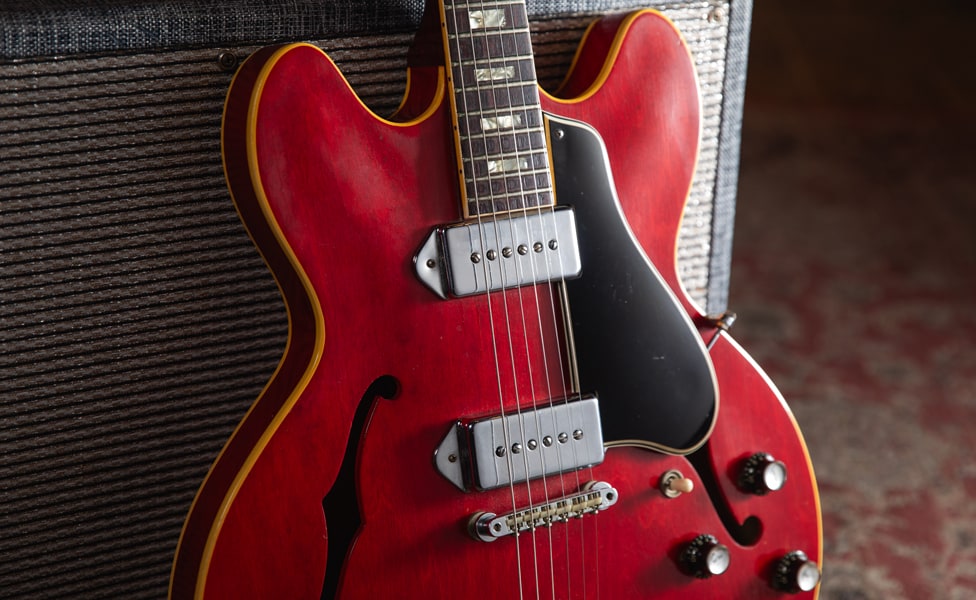
Pictured: 1967 Gibson ES-330TDC in Cherry Red
• Late 1930s: Les Paul builds his "Log" guitar as a proof of concept for solidbody electric guitars
• 1957: Gibson President Ted McCarty recruits staff engineers to begin development of a thinline archtop guitar with a solid center block
• February 1958: First pre-production ES-335 models are shipped to Gibson's parent company, CMI (Chicago Musical Instruments), with three-layer (maple/poplar/maple) laminated top, no neck binding, shallow neck angle, cutdown ABR-1 bridge and more of a point on the cutaways
• April 1958: First ES-335 Production Serial Number (A27483) recorded
• Late 1958: Binding is added to ES-335 fingerboard to differentiate it from the lower-end ES-thinline models, cutaways are rounded to "Mickey Mouse ear" shape and cutaway bulges increased to more closely mimic a carved top
• Late 1958–early 1959: Introduction of ES-355, ES-330 and ES-345 in that order
• 1959: Due to collapse of some of the cutdown ABR-1 bridges, the neck angle is increased; the laminate is changed from three layer to four layer (maple/poplar/poplar/maple) due to incidence of stress cracks around the output jack; cherry finish is added to the existing sunburst and natural finishes
• 1960: Introduction of the short pickguard, metal caps on control knobs and double-ring Kluson tuners; natural finish begins to be phased out
• 1961: "Sideways" Gibson Vibrola becomes standard on the ES-355, option on the ES-335 and ES-345
• 1962: The ES-335 loses its dots as it is shifted to small block fingerboard inlays; ES-330's P90s get metal covers; natural is now a custom order finish
• 1963: The Gibson Vibrola with "lyre" tailpiece cover replaces the sideways Vibrola; the end of "Mickey Mouse ear" cutaways as they are redesigned to be slightly pointed, and the cutaway bulge is decreased
• 1964: The Trini Lopez Standard, an ES-335 with diamond-shaped cutouts instead of traditional "f" holes, is introduced
• 1965: The trapeze tailpiece replaces the stop tailpiece on ES-335 and 345 guitars
• 1966: Headstock angle decreased from 17° to 14° across the whole ES-300 family, and the crown inlay on the ES-335 and 345 is moved lower on the headstock; Pelham Blue and Sparkling Burgundy custom color options make their first appearance
• 1968: Norlin takes over; headstock logos are changed from holly with inlaid logos to pantograph painted logos; headstock slightly widened
• 1969: Introduction of walnut and darker sunburst finishes; the ES-330 neck, which had joined the body at the 16th fret, is changed to join at the 19th fret, the same as the rest of the family; three-piece mahogany (occasionally walnut) necks introduced
• 1970: Fiber headstock veneers replace holly; the headstock/neck volute is introduced, as are pickup covers embossed with the Gibson logo
• 1971–72: ES-330 and Trini Lopez models discontinued
• 1973: The ES-335 gets metal buttons on the tuners, and embossed pickup covers are discontinued
• 1974: Three-piece neck gets changed from mahogany/walnut to maple
• 1975: Gibson Nashville plant opens
• 1976: Gibson Kalamazoo plant closes; the ES-335 gets coil taps and an extra toggle switch
• 1978: Introduction of the TP6 fine-tuning tailpiece
• 1979: Tuners with pop-out/retractable cranks introduced on higher-end models (they wouldn't last long)
• 1980: B.B. King Standard and Custom models are introduced
• 1982: ES-335 Dot Marker reissued; ES-355 and ES-345 models are dropped
• 1986: Norlin sells Gibson to investor group headed up by Henry Juszkiewicz and David Berryman
• 1993: Gibson Custom begins operation in Nashville, and the Gibson Historic Collection is introduced
• 1994–96: Gibson Custom versions of the ES-335, 345 and 355 are introduced, including limited-run reissues with long pickguards and oval orange labels; the smaller-body ES-336, which would lead to the current ES-339, was introduced
• 2000: Gibson Memphis factory opens, and all ES-family guitar construction is moved to Memphis
• 2005: Eric Clapton Crossroads ES-335s are introduced and sell out in two days; Alvin Lee and Larry Carlton Signature models are introduced
• 2006: B.B. King "Lucille" introduced
• 2007: Alex Lifeson, Roy Orbison and the first Dave Grohl Signature are introduced, along with the Keifer Sutherland Signature CS-336, as well as the ES-339
• 2019: Memphis factory closed
Note: There are a lot of custom and short-lived variations of the ES-335/45/55 that we haven't touched on in this timeline, but we've tried to hit the main highlights and turning points across the decades.
Meet the Modern ES-300 Family
The following is a quick overview of the features of the current line of regular production ES-300 family guitars from Gibson. For more details and in-depth look at what's available today, see our buying guide to the ES-335.
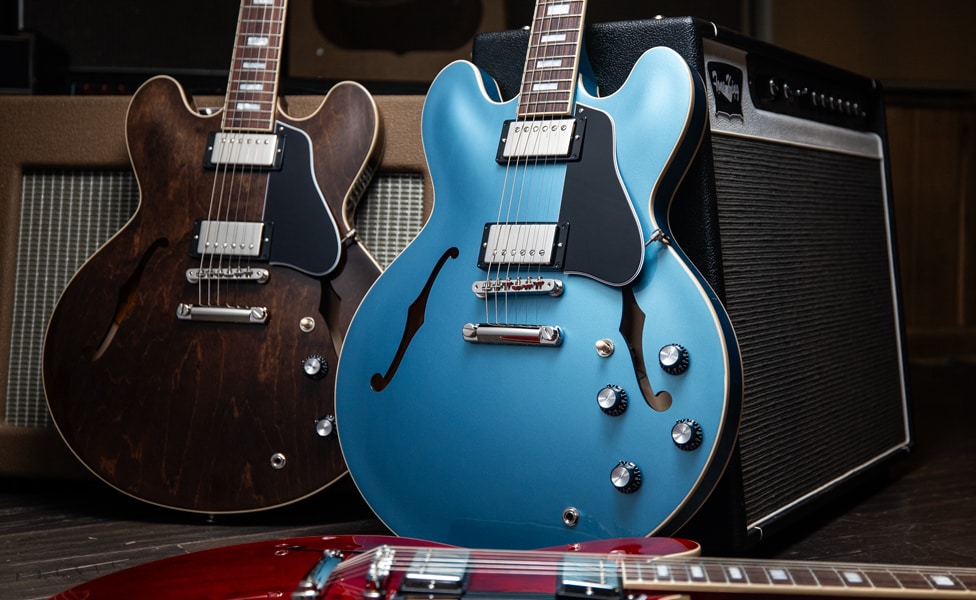
Pictured: Gibson ES-335 '60s Block
Comparing Gibson's ES-300 Models
|
Model |
Features |
Availability |
|
ES-330 |
|
Gibson Custom or Limited Edition |
|
ES-335 |
|
Production, Gibson Custom and Limited Edition/Artist |
|
ES-339 |
|
Production, Gibson Custom and Limited Edition/Artist |
|
ES-345 |
|
Production, Gibson Custom or Limited Edition/Artist |
|
ES-355 |
|
Production, Gibson Custom or Limited Edition/Artist |
15 Essential ES-335 Family Players and Songs
The sheer number of players over the years who've picked up an ES-335 (or relative) means that we can't get to everybody, but for the curious, here's a litany of influential ES-300 family players and some of their recordings that best feature the instrument.
Chuck Berry
Although the most common image of Chuck Berry is with a Gibson ES-335, 345 or 355, his biggest hits were recorded with his ES-350, one of the fully hollow ancestors of the ES-335. However, once he started playing an ES-335 in the early '60s, Berry never looked back. The 1987 film Hail! Hail! Rock ’n’ Roll heavily features one of Berry's red ES-355s. All of his post-1962 hits, like "Nadine (Is It You?)," "No Particular Place to Go," "You Never Can Tell," and his last big hit, "My Ding-a-Ling," would have been recorded with one of those ES-300 family guitars (he owned a number, and we couldn't find specific documentation as to which one was used on which recording).
Alvin Lee
Back before there was "shred," there was Alvin Lee and his band Ten Years After. This British rocker and his sticker-covered, cherry red ES-335 riveted audiences, and his performance of "I'm Going Home" at the 1969 Woodstock Music and Arts Fair was a serious showcase for chops that, at the time, seemed positively superhuman. A deep cut well worth checking out to hear Lee's Charlie Christian-inspired chops is the version of Woody Herman's "Woodchopper's Ball" on the Ten Years After live album, Undead.
Trini Lopez
More known as a singer in the folk-pop tradition, Trini Lopez was a big enough star in the early 1960s to get his own signature model based on the ES-335, featuring diamond-shaped cutouts rather than the traditional "f" holes. His big hit was his version of the 1949 Pete Seeger/Lee Hays-penned "If I Had a Hammer (The Hammer Song)," released as a single in 1963, probably to capitalize on Peter, Paul and Mary having had a hit with the song the previous year. The B-side of the single was a cover of Ray Charles' "Unchain My Heart."
Dave Grohl
Speaking of the Trini Lopez Signature model, it's the guitar that Dave Grohl has had reworked as his signature model. When he stumbled across a used one while touring with Nirvana, he had no idea who Trini Lopez was, but was taken by the look of the instrument (especially it's unique diamond-shaped cutouts and Firebird style, and six-on-a-side headstock), picked it up and fell in love. Grohl has said that while he may occasionally pick up a different guitar in the studio, it's almost always his original Trini Lopez or one of his signature versions of the guitar. So, pretty much any of your favorite Foo Fighters songs are a great place to get a taste of that instrument.
Eric Clapton
Famously bought from American guitarist Jerry Donahue, who was working at Selmer Music in London at the time, Eric Clapton's cherry red 1964 ES-335TDC, and its appearance during Cream's "Farewell" concert and album, as well as during the subsequent Blind Faith tour, was an inspiration to many players to get one for themselves. Another Eric, Eric Johnson, cited Clapton as the reason he bought his, with which he famously recorded his Grammy Award-winning "Cliffs of Dover." For Clapton cuts with the original guitar, check both the live cuts on the Cream Goodbye album and Clapton's solo effort, From the Cradle. Note: When Clapton decided to auction off this guitar to benefit his Crossroads Center, it was purchased by Guitar Center and is a treasured part of our collection. Guitar Center worked closely with Gibson Custom to meticulously recreate this guitar for a very special limited edition.
Larry Carlton
What list of ES-335 players would be complete without the man who has become known as "Mr. 335," Larry Carlton? Starting out as a jazz player, Carlton was earning reputation as an L.A. session player and was looking for an instrument that would give him the versatility needed for the wide variety of sessions he was being called for. After sitting down with three ES-335s at a local music store, he picked out the one that sounded the best to him unplugged and has been playing that guitar ever since, in sessions and in his extensive career as a solo performer. His solo on Steely Dan's "Kid Charlemagne" has been an icon since it was released. You might also want to check out the recent rerelease of Live on Wowow Tokyo 1995, a live set Carlton recorded with his old friend (they grew up together in Rancho Palos Verdes, California), jazz guitarist Lee Ritenour.
Alex Lifeson
Some of the most memorable images of Rush guitarist Alex Lifeson are with his white ES-355, but the guitar he started with, and the one that inspired him as a young player, was the ES-335. Lifeson has said that he was attracted to the ES-335 because it seemed like it was something more than just a rock instrument. Rush's 2011 live album, Moving Pictures, is a great way to discover Lifeson's ES-family tones.
Bob Weir
The Grateful Dead rhythm guitarist's axe of choice during the band's early years was a 1965 ES-345, though he would frequently play a tobacco sunburst ES-335 as well. Our tape-collecting Deadhead friends can probably point to a better performance, but Weir's tone and playing on "Playing in the Band" from the 1971 Grateful Dead (aka Skull and Roses) live album is an excellent example of how he used his ES-335-style guitar.
Eddie Phillips
For many, Eddie Phillips of British pop-rock band The Creation is a mysterious name, if they've ever heard it. Phillips, though, with his cherry red ES-335, was an early creative user of feedback, playing through a 200-watt Marshall stack. He was also the first we know of to take a violin bow to an electric guitar, inspiring Jimmy Page, among many others, to follow suit. Check out "Painter Man" from the compilation The Best of The Creation for a shot of pre-psychedelia guitar madness.
B.B. King
B.B. King is so identified with his Gibson ES-355 that people forget that he played a Telecaster in the early 1950s. But shortly after they came out in 1958, King was seen sporting a custom-built ES-335 that featured both stereo output and a Varitone switch (and wouldn't we all like to know what became of that particular guitar?). King's Live at the Regal album was a breakthrough to a larger audience for him and tops lists of Top 100 blues albums. Any cut—seriously, any cut off this album—is a great introduction to what made him an inspiration to so many blues players. If we absolutely had to, we'd point to "You Done Lost Your Good Thing Now," both for its heartfelt guitar and stunning vocal performance.
Marcus King
You can't talk about modern blues guitar without mentioning Marcus King. This Greeneville, South Carolina's blend of blues, soul and rock is driven by his ES-345, both his original and his current signature model. Check "The Well" from his 2020 release El Dorado for a sample of hard-driving, bluesy tone and playing.
Gary Clark Jr.
Gary Clark Jr. is another contemporary artist who has come to feature ES-300 family guitars in his work. Between his Gibson Custom ES-355 and a vintage ES-345 he obtained through Guitar Center's Vintage Collection, many of his recent recordings and appearances—his recent induction in the Rockwalk Hall of Fame and appearance at the 2023 Crossroads Festival, for example—have featured these guitars. Check out his latest release, JPEG RAW, for a taste of how this artist, mostly using that ES-355, has evolved from his blues-drenched debut.
Luther Dickinson
North Mississippi Allstars guitarist Luther Dickinson is one of the many contemporary blues players who has prominently featured an ES-335 in his playing. His limited-run signature 335 featured P90s instead of the normal humbuckers, and a Bigsby tailpiece. Check out "JR" off their seminal World Boogie Is Coming album for some killer tone.
Bill Nelson
Guitarist and producer Bill Nelson's early 1970s band Be-Bop Deluxe displayed adventurous, subtly layered songwriting while featuring guitar pyrotechnics on Nelson's sunburst ES-345. His solo career post-Be-Bop Deluxe has been genre-blending, sometimes quixotic, but always fascinating music. Check out Be-Bop Deluxe's 1976 album Sunburst Finish for a sampling of great guitar tones and playing.
Marty McFly
Okay, we know he's a fictional character portrayed by Michael J. Fox. And we've seen all about Marty McFly, in a move perhaps unconsciously appropriate for a film about time travel, playing a guitar that wouldn't exist yet for almost four years. On the other hand, it wouldn't be the first time Hollywood has gotten the gear wrong. Nevertheless, the appearance of a cherry red ES-345 in a key scene in Back to the Future speaks to the iconic nature of the instrument. Its contours and sound have been insinuated into pop culture in a way only a handful of guitars have managed.
Honorable Mentions
The list we presented here is certainly not all inclusive and is a selection of who we felt were key ES-335 (and siblings) players over the years—and we're sure that, as with any list of this sort, there will be disagreements. There are so many, others that we can't end this section without mentioning a number of players who have been aficionados of the 335 and its relatives.
On the jazz side we have Emily Remler and her modded ES-330; Grant Green and his 330, Pat Martino's signature guitar and Howard Roberts signature Fusion model, which were essentially single-cutaway ES-335s; and Lee Ritenour, who made his reputation with an original dot-neck 335. A special shout-out to Chicago's George Freeman, born in 1927, whose funky brand of jazz has him still recording and performing with his red 335 in his late 90s.
On the rock side there are Johnny Marr; Warren Haynes; Jorma Kaukonen and Marty Balin of Jefferson Airplane/Starship; Steve Howe; Ritchie Blackmore, who recorded the first three Deep Purple albums with the ES-335 he'd used as a session player in London; Paul Weller and Noel Gallagher.
Blues players on the 335 side include Freddie (or Freddy—he was billed as both over the years) King, Otis Rush, John Lee Hooker, Magic Sam and Johnny "Guitar" Watson.
There are tons more, and if you have favorites we missed, please let us know on our Instagram or Facebook. We're always down for learning more.
Putting it in the Case
So, there you have it, an overview of the history of a guitar that was, at its conception, far more revolutionary than mere appearances would indicate. An instrument that is unrivaled in versatility, unmatched in innovation—and, we say, as owners and players of them, strikingly good looking—the ES-335, or one of its family members, deserves to be in every serious player's collection.
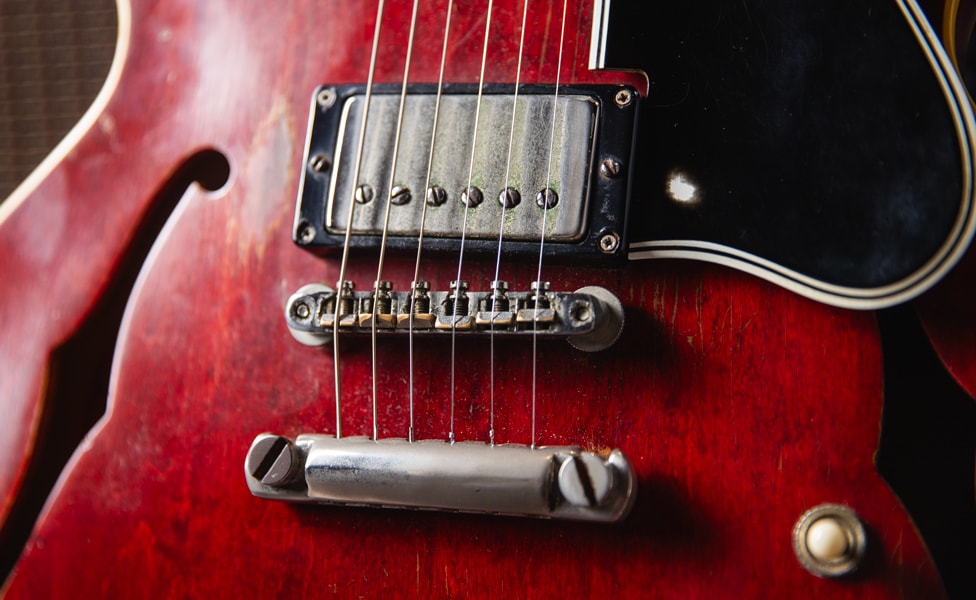
Pictured: 1961 Gibson ES-335 in Cherry Red
Whether you're trying to track down a vintage version, lusting after your own custom build, yearning for a particular artist model or just shopping for one of the excellent current production versions, we'd love to help you find the guitar that matches up perfectly. So, drop by your local Guitar Center to play one (or several), or dial up our Call Center and ask one of our knowledgeable Gear Advisers to track down the one that's absolutely right for you.










